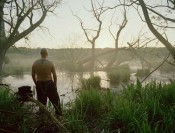Julian Rosefeldt’s four-screen installation (Super 16-mm film transferred to DVD) The Ship of Fools, 2007, at first seems a kind of study in art history or visual culture. It features a stock of unmistakable European Romantic motifs, references to landscape painting that double as stereotypical cinematic mises-en-scène (a moonlit forest at night, early morning mist rising off a lake, and so on), and symbols signposting German political history. However, what initially looks vaguely sociological ends up reading as more broadly structural and philosophical – an excavation of existential preoccupations.
Projected side by side, the four looped sequences start and end simultaneously. On the left, a forest (shown by production stills in another room to be a single old oak ringed by wooden fencing, while the moon is shown to be a colossal lighting rig) is overrun by a pack of German shepherds, whose baying and yelping provide a continuous accompaniment to the installation. The adjacent scene is set in a woodland pond at twilight. A man walks into the shot, removes his upper garments, and wades out into the middle distance: shades of Ludwig of Bavaria’s suicide in Visconti’s 1972 biopic-except that here, the (possible) suicide victim is a burly, bald-headed individual whose shoulders and back display a fascist-looking spread eagle and Iron Cross tattoo.
Beside this is a more intricately edited sequence. It opens with a closeup on a generic-looking Symbolist landscape painting hanging in a superficially palatial but actually rather shabby interior, where a young opera singer in white satin and pearls is performing a Wagnerian aria to a small audience. A wipe transition introduces another scene, a lakeside shrouded in mist (or smoke-machine fog), where a Caspar David Friedrich-esque figure, solitary and clad in vaguely nineteenthcentury garb (boots, a wide-brimmed hat, and a flowing coat) walks beside a lake and poses with an eagle on his raised arm. The bird takes flight, while on the sound track the climax of the “Liebestod” from Wagner’s Tristan and Isolde competes with the howling dogs.
The “ship” of the title appears on the final screen. In fact, it’s a pleasure cruiser sailing on a placid lake, gliding into view from a distance. As it draws near, we see a throng of figures standing on the upper deck, energetically waving German flags. The boat eventually slides out of the shot, past a lone hiker standing immobile on the shore (and leaning on a stick in another Friedrich paraphrase, this time from the Wanderer Above a Sea of Mist, 1818). There is an absolute, almost absurd lack of interaction between the ship’s passengers and the hiker, and on reflection, the scenarios on each screen seem equally disconnected: hermetic narratives in which hollow rituals are endlessly repeated. The original “Ship of Fools” was a late-fifteenth-century satirical poem, but although Rosefeldt’s pieces appear to reflect on a certain impotent self-absorption at the heart of Romanticism, satire seems entirely the wrong label. Satires presuppose something exterior to the work – specifically, an external target of critique. Here, though, landscape is used to depict a hermetically sealed diegetic universe, one with no outside, a claustrophobic place where video looping is much more than just a technical device to keep the footage running. Like Rosefeldt’s remarkable 2004-2006 project Trilogy of Failure (conveniently on show concurrently at London’s Royal Academy of Arts, in its entirety for the first time), we end up glimpsing a vision of absolute solipsism, a disturbing kind of “anti-sublime.”
Julian Rosefeldt: The Ship of Fools showed at Max Wigram, London, from November 21 – December 22 2008
Text © Rachel Withers & Artforum International Magazine, Inc. 2009. Images © the artist.

